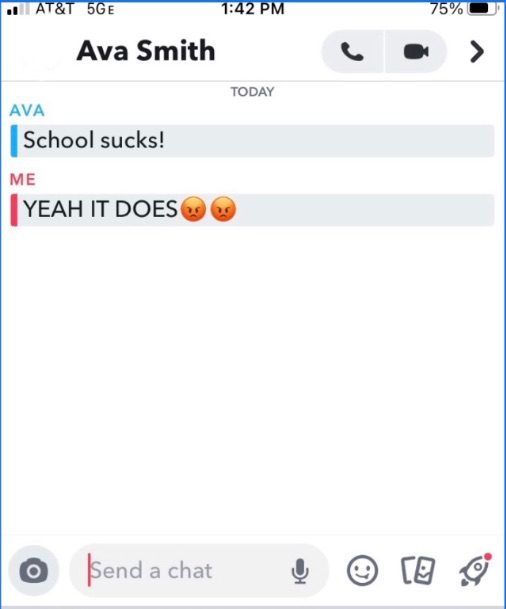Free speech of students in question in Supreme Court case
The current policy for a snapchat badmouthing a school that is screenshotted and sent from off campus like this is disciplinary action. The Supreme Court is currently debating if this is a violation of students’ free speech.
June 2, 2021
Since 1969, the standard for freedom of speech in schools has been solely based on the decision in the Tinker v. Des Moines case in which a group of students wore black armbands on their uniforms to protest the Vietnam war, which was deemed within the realm of free speech that the government protects. Now in the 21st century, modern technology and a new case, Mahanoy Area School District v. B.L, has sparked a debate in the Supreme Court about deciphering how students are allowed to express themselves inside and outside of school.
The oral debates were released on April 28. Oral arguments are the presentation of a case in which both sides receive 30 minutes to speak and answer the Supreme Court justices’ questions. The debates revealed the justices leaning more toward protecting students’ free speech by pointing out how hard it is to discern what is and isn’t punishable by asking questions about many scenarios including one that related to the case in question: Can schools punish students for swearing at home? If this was so, schools would do nothing but punish students.
Junior Elizabeth McMahon agrees that the constitutionality of rules regulating speech by students in schools are not black and white, but that the Supreme Court has historically been fair in their rulings.
“I feel as if the Supreme Court has ruled fairly in most cases involving schools,” McMahon said. “They have protected the rights of students and kept the schools safe from danger. Furthermore, ruling in her favor will uphold this trend.”
Though the case is being debated in the courtroom, both sides agree that students benefit from being able to use their voices without feeling restricted and regulated by their school. Deputy superintendent Jon Dean says that the effect free speech has on the way students feel at school is also a big priority.
“Students should continue to have free speech rights, but we also must keep kids safe (including emotionally safe) inside of school,” Dean said.
A student’s freedom of speech comes with a lot of outliers, starting with how they might use it referring to classmates. It is crucial that schools find the balance to make students comfortable with expressing themselves while protecting all the students and teachers around them. Dean believes that freedom of speech is an important right that students should experiment with in the proper setting.
“I think it is important that our students be able to exercise their freedom of speech in a school setting,” Dean said. “Of course, limits have to exist to keep kids safe (such as no bullying) and to allow teachers to teach.”
Principal Kate Murray believes that student free speech is important, but that it is schools’ jobs to teach their students how to use their voices in a productive and respectful manner.
“I think it is about education and helping teenagers find their voice, but also understanding where and when and how to use that voice,” Murray said. “Teenagers are crucial to a school and to the educational environment and their opinions and perspectives need to be valued and heard and then it becomes our responsibility as educators particularly once this case is decided to help them understand when and where and how to use those voices.”
While the case has not been decided yet, Murray believes whatever the outcome may be, it will be a learning experience for everyone.
“I look forward to understanding the perspective of the Supreme Court,” Murray said. “(I look forward to) understanding what the next steps will be for schools.”












